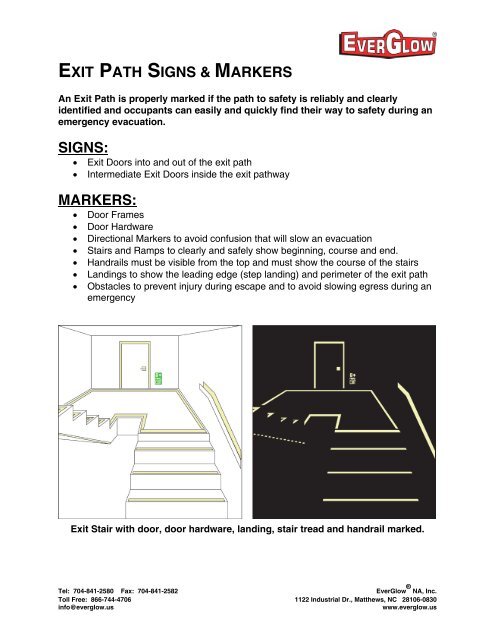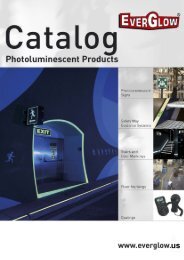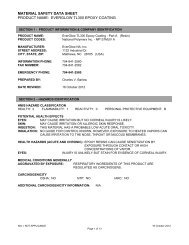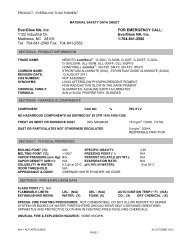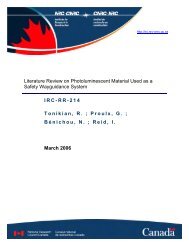EXIT PATH SIGNS MARKERS
EverGlow Code Approved Photoluminescent Exit Path ... - Everglow.us
EverGlow Code Approved Photoluminescent Exit Path ... - Everglow.us
- No tags were found...
Create successful ePaper yourself
Turn your PDF publications into a flip-book with our unique Google optimized e-Paper software.
<strong>EXIT</strong> <strong>PATH</strong> <strong>SIGNS</strong> & <strong>MARKERS</strong><br />
An Exit Path is properly marked if the path to safety is reliably and clearly<br />
identified and occupants can easily and quickly find their way to safety during an<br />
emergency evacuation.<br />
<strong>SIGNS</strong>:<br />
• Exit Doors into and out of the exit path<br />
• Intermediate Exit Doors inside the exit pathway<br />
<strong>MARKERS</strong>:<br />
• Door Frames<br />
• Door Hardware<br />
• Directional Markers to avoid confusion that will slow an evacuation<br />
• Stairs and Ramps to clearly and safely show beginning, course and end.<br />
• Handrails must be visible from the top and must show the course of the stairs<br />
• Landings to show the leading edge (step landing) and perimeter of the exit path<br />
• Obstacles to prevent injury during escape and to avoid slowing egress during an<br />
emergency<br />
Exit Stair with door, door hardware, landing, stair tread and handrail marked.<br />
Tel: 704-841-2580 Fax: 704-841-2582 EverGlow ® NA, Inc.<br />
Toll Free: 866-744-4706 1122 Industrial Dr., Matthews, NC 28106-0830<br />
info@everglow.us<br />
www.everglow.us
Exit Path Signs & Markers<br />
Created: December 11, 2006<br />
New York City:<br />
The City Council directed the Department of Buildings to create a specification for safety<br />
grade photoluminescent (PL) exit path marking because PL technology is:<br />
• 100% Reliable<br />
• Does not require electricity, batteries, lamps, wiring<br />
• No radioactive or toxic components<br />
All photoluminescent exit pathway signs and markers used in New York City<br />
must now conform to RS 6-1 and RS 6-1A. All EverGlow aluminum signs and markers,<br />
and all EverGlow films and tapes, exceed the requirements of the current codes and<br />
installation services are available. All egress symbols (running man character) and<br />
directional arrows conform to ISO 7010. All egress signs and markers used in the exit<br />
pathway conform to the green specified in ANSI Z535.1 - 2002.<br />
RS 6-1 specifically requires photoluminescent exit path signs and markers at<br />
the floor level (top of each sign or marker must be within 18 inches of the floor) in<br />
emergency exits. NYC code allows the use of photoluminescent signs in place of<br />
standard (non-photoluminescent) signs where they are required inside emergency exits<br />
and by elevators. So long as EverGlow signs are properly labeled with an MEA number<br />
the following signs can be used: fire extinguisher and other emergency<br />
equipment signs, floor and stair identification signs, exit floor plans, and elevator signs.<br />
New York City does not currently require the use of UL listed exit signs or components<br />
used in exit path marking systems specified in RS 6-1. The Department of Buildings is<br />
responsible for determining which high rise buildings must conform to RS 6-1 and city<br />
building and fire department inspectors can require building owners to comply. Safety<br />
grade photoluminescent exit path marking systems installed voluntarily in buildings<br />
where they are not required must also conform to the new luminance standards.<br />
Exit Stairs with side edge stair markers and strips across the stair nose.<br />
2<br />
© 2006 EverGlow NA, Inc.
Exit Path Signs & Markers<br />
Created: December 11, 2006<br />
Outside New York City:<br />
California requires Exit Path Marking in specific occupancies. California also requires<br />
floor level Exit Signs in addition to the traditional over-the-door signs. Other states and<br />
jurisdictions have similar requirements and some building owners install exit signs and<br />
exit path marking voluntarily. Federal agencies have also created standards which<br />
mandate that exits be clearly marked for use in an emergency.<br />
The model code organizations, ICC and NFPA, have language in their building and fire<br />
codes now to specify that all exit signs be listed to UL 924. There are certain<br />
occupancies which also require exit path marking be listed to UL 1994. Although there<br />
is widespread acceptance that exit signs are a good idea, there is only recently serious<br />
discussions to require exit path marking in more occupancies. New York City and<br />
California have certainly led the nation protecting their citizens with this code language.<br />
Signs. Exit Signs which are NOT listed to UL924 can be found in many buildings<br />
around the country. EverGlow offers many different exit signs which can be properly<br />
and safely used in offices, factories, warehouses and other occupancies.<br />
Most often these signs are installed in existing occupancies to more clearly identify the<br />
exit path after renovations have been made to the original structure. Often, especially in<br />
warehouses, retail and assembly occupancies, these large exit signs will be mounted<br />
above storage or display racks which otherwise obscure the visibility of the exit location.<br />
All signs can be framed and attached to the wall or ceiling. Custom designs are<br />
available. All EverGlow signs and markers meet or exceed all local, national and<br />
international standards and codes.<br />
Directional Markers. Directional indicators used in Exit Path Marking Systems can<br />
take many forms. Most often the design and construction of these directional markers is<br />
determined by the area to be marked (tenant space, exit stairs or corridors) and the<br />
surface conditions in these areas.<br />
Closely spaced individual markers can be safely used instead of an EverGlow tape or<br />
strip marker on most surfaces. Typically, individual markers are uniformly placed 8-12<br />
inches apart (center to center). These are especially useful on brick, block or stone<br />
surfaces where the surface is broken or not uniform.<br />
Placement of directional markers, unless otherwise directed by building or fire codes or<br />
the AHJ should be at floor level, within 18 inches of the floor. Additional guidance<br />
markers can be installed on the wall at eye level- approximately 60 inches from the floor<br />
surface.<br />
For stairs, handrails should also be marked. The top surface of the handrail can best be<br />
marked with a 1 inch wide EverGlow tape. If the top surface of the handrail will not hold<br />
the tape, then a suitable alternative is to mark the wall just above the handrail with a 2<br />
inch wide tape or closely spaced individual markers.<br />
3<br />
© 2006 EverGlow NA, Inc.
Exit Path Signs & Markers<br />
Created: December 11, 2006<br />
Utility Bunker with obstacles and exit path marked.<br />
Parking Basement with obstacles and exit path marked.<br />
Interior Corridor marked along the baseboard.<br />
4<br />
© 2006 EverGlow NA, Inc.


